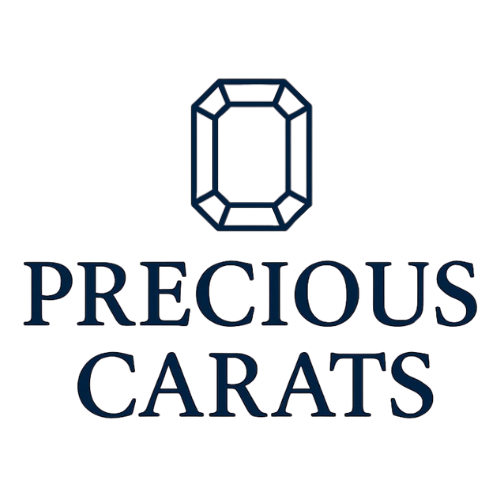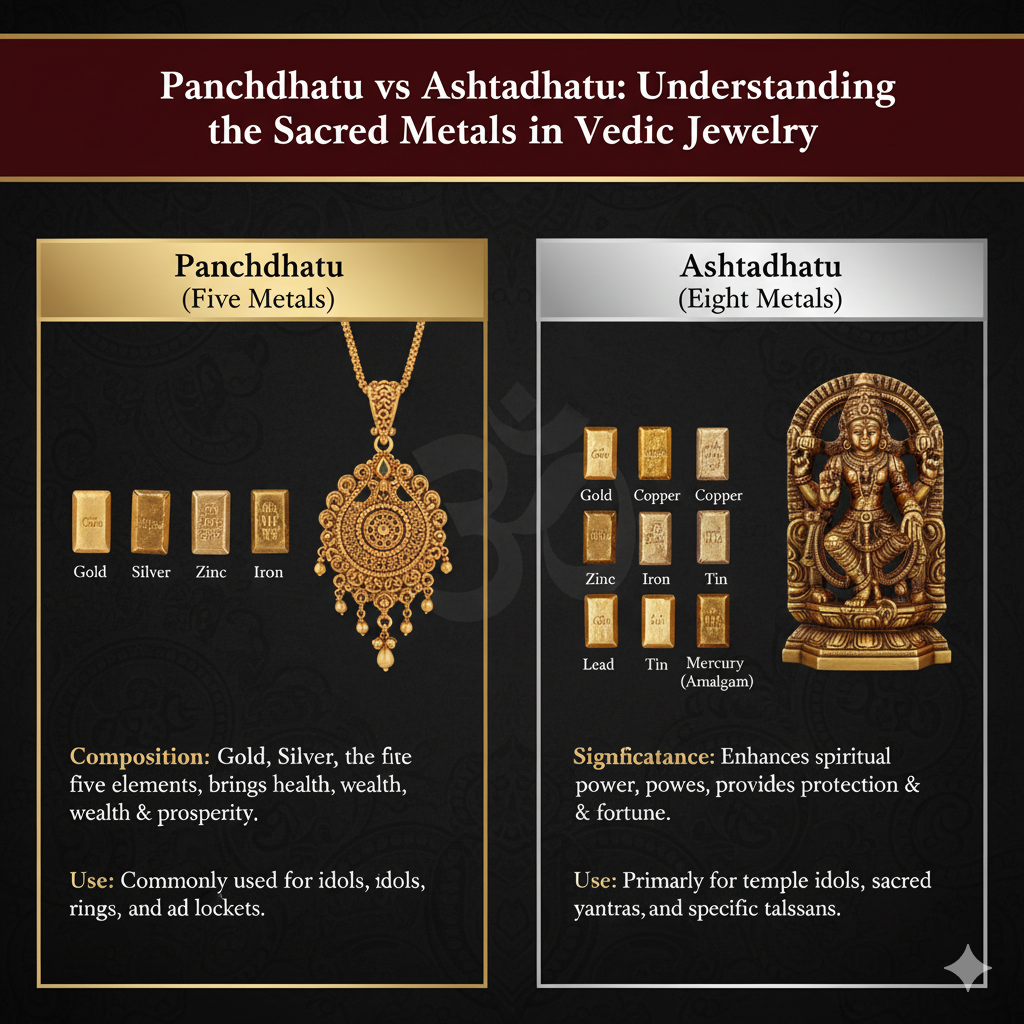Introduction
In the world of astrological and temple jewelry, the choice of metal carries deep symbolic meaning. While gemstones hold planetary energies, the metal acts as the bridge — transmitting those vibrations into the body. Two of the most revered alloys in Indian tradition are Panchdhatu and Ashtadhatu.
Both are sacred and ancient, yet their purpose, composition, and energy are very different. Let’s understand how they compare.
What is Panchdhatu — The Metal of Balance
Literal Meaning:
“Panch” means five, and “Dhatu” means metal — the alloy of five elements.
Composition:
Commonly includes:
-
Gold (Swarna)
-
Silver (Rajat)
-
Copper (Tamba)
-
Iron (Loha)
-
Zinc (Yashada)
Some regional traditions may substitute brass or lead, depending on the jeweller.
Symbolism & Spiritual Value:
Panchdhatu represents the five great elements (Pancha Mahabhutas) — Earth (Prithvi), Water (Jal), Fire (Agni), Air (Vayu), and Space (Akash).
It is believed that wearing Panchdhatu jewelry harmonizes the body’s elemental balance and strengthens the aura.
Use in Astrology Jewelry:
Panchdhatu is widely used for rings and pendants meant for planetary remedies — especially for Jupiter (Pukhraj), Moon (Moti), Mars (Moonga), and Ketu (Cat’s Eye).
Its neutral energy allows it to conduct almost any gemstone’s vibration effectively, making it the all-purpose alloy for astrology jewelry.
Practical Qualities:
-
Affordable and durable
-
Retains shine with mild polishing
-
Ideal for daily wear
-
Slightly golden-bronze tone that ages gracefully
What is Ashtadhatu — The Metal of Power and Divinity
Literal Meaning:
“Ashta” means eight — the alloy of eight metals.
Traditional Composition:
-
Gold
-
Silver
-
Copper
-
Iron
-
Lead
-
Tin
-
Zinc
-
Mercury (replaced by brass or antimony in modern times for safety)
Symbolism & Spiritual Value:
Ashtadhatu is considered more divine and temple-oriented than Panchdhatu.
It represents the eight forms of wealth (Ashta Lakshmi) and the eight directions of the cosmos.
It is said to invoke protection, strength, and divine blessings — especially when used in idols, temple doors, or sacred relics.
Use in Jewelry:
Although Ashtadhatu is less common in rings and pendants today, it is still used in:
-
Idol casting and temple jewelry
-
Spiritual amulets and Rudraksha holders
-
Protective talismans (Tabeez)
Because of its dense and powerful composition, Ashtadhatu is believed to store and radiate spiritual energy for long durations.
Practical Qualities:
-
Heavier and denser than Panchdhatu
-
Slightly darker tone
-
May oxidize faster due to mixed metals
-
Best suited for occasional or ritual wear rather than daily use
Panchdhatu vs Ashtadhatu — Key Differences at a Glance
| Feature | Panchdhatu | Ashtadhatu |
|---|---|---|
| Meaning | Alloy of 5 metals | Alloy of 8 metals |
| Primary Purpose | Astrology jewelry, gemstone rings & pendants | Temple idols, divine artifacts, spiritual amulets |
| Energy Nature | Harmonizing, balanced | Protective, powerful |
| Common Composition | Gold, Silver, Copper, Iron, Zinc | Gold, Silver, Copper, Iron, Lead, Tin, Zinc, Mercury (or Brass) |
| Astrological Use | Works for most gemstones | Rarely used for planetary gems |
| Durability | Good for daily wear | Heavy and dense, not ideal for everyday wear |
| Appearance | Warm golden-bronze hue | Darker, antique tone |
Which Should You Choose for Astrology Jewelry?
Choose Panchdhatu if your purpose is astrological or planetary — to strengthen Jupiter, Moon, Mars, or other benefic planets.
Choose Ashtadhatu if your purpose is spiritual or ritualistic — for temple use, meditation, or divine protection.
In astrology jewelry, Panchdhatu is preferred because it is energetically lighter, conducts planetary vibrations smoothly, and is more comfortable for everyday use.
Final Thoughts
Both Panchdhatu and Ashtadhatu carry the sacred memory of India’s metallurgical wisdom.
Where Panchdhatu brings balance, Ashtadhatu brings power.
At PreciousCarats.com, we honour these traditions in every handcrafted piece — using the right metal composition, purity, and proportion so that your gem doesn’t just look beautiful, it feels alive.

